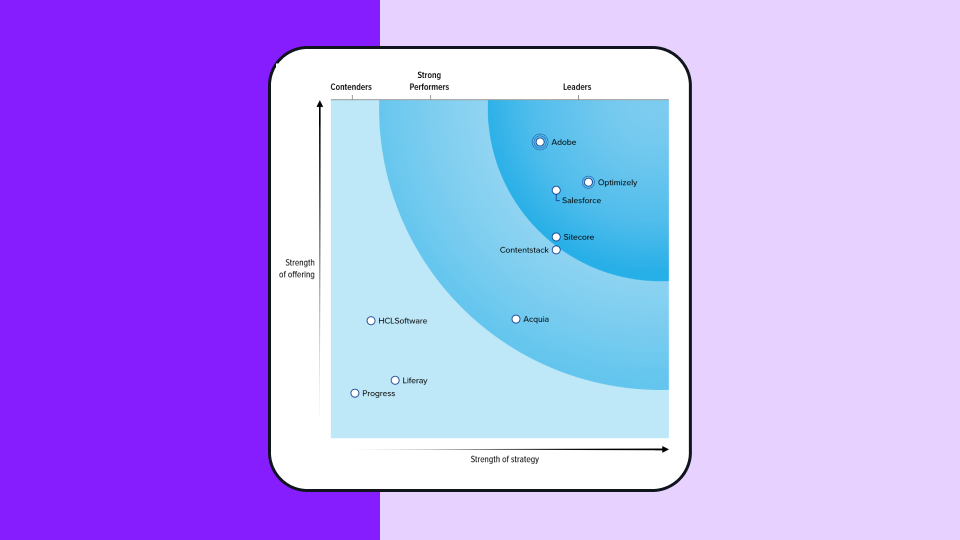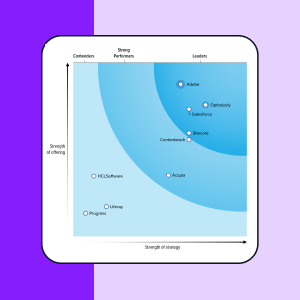Product-led growth (PLG)
What is Product-led growth (PLG)?
Product-led growth (PLG) lets prospects try your product before buying, using hands-on experience to drive acquisition, conversion, and expansion instead of traditional sales processes.
But here's what nobody tells you: most PLG teams spend months rebuilding the same foundations before they can focus on actual growth strategy. You set up tracking, fix onboarding, and optimize pricing pages, the same checklist at every company.
Users experience value first through freemium models or free trials, then decide to pay for expanded features based on demonstrated benefits. This removes barriers to product exploration through self-service onboarding, where users evaluate software on their timeline.
For example, at Optimizely, we offer visitors a free feature flagging option, so they can roll out features and prove value with less risk, at no cost.
How product led growth reshapes business strategy:
-
Traditional workflow: Marketing generates leads → Sales converts prospects → Customer success retains accounts
-
PLG workflow: Product attracts users → Product converts users → Product expands accounts
Teams align around user experience optimization. Marketing focuses on demand flywheels. Sales targets product-qualified leads. Customer success uses product data for expansion.
Satisfied users become acquisition channels through referrals and viral features. Each positive experience creates growth momentum without increased sales spend.
Product-led growth vs. sales-led vs. marketing-led
Here's the difference between the three approaches:
- Sales-led growth: Revenue driven by sales teams, lengthy enterprise cycles, relationship-focused conversion
- Marketing-led growth: Revenue driven by campaigns and content, lead generation emphasis, brand awareness focus
- Product-led growth: Revenue driven by product usage and user experience, self-service conversion, value demonstration through direct interaction
PLG creates fundamental changes in measurement. Instead of tracking marketing qualified leads aka MQLs, product led growth companies focus on product adoption, time-to-value, and user engagement as primary growth indicators.
The "aha moment" is when users first experience meaningful value. This milestone determines trial-to-paid conversion rates. Here are a few examples:
- Facebook: Adding seven friends within 10 days
- Slack: Sending 2,000 team messages
- Dropbox: Installing the desktop app and syncing the first file
- Zoom: Completing the first successful video call
Time-to-value measures how quickly users reach their aha moment. Successful PLG companies optimize onboarding to minimize this timeframe, removing friction between signup and value realization.
The PLG infrastructure problem nobody talks about
Every PLG implementation follows the same painful pattern. We've seen it firsthand at company after company:
- Months 1-2: Realize the analytics system is broken. Spend weeks configuring event tracking and attribution. Marketing can't tell which channels drive valuable users.
- Months 3-4: Discover that onboarding confuses users. Session recordings show people dropping off before experiencing value. Trial-to-paid conversion sits embarrassingly low.
- Months 5-6: Notice that freemium users cost more than they generate. No clear upgrade triggers. Customer success complains about unqualified leads.
- Months 7-8: Finally start testing improvements. Small wins on activation rates. Team celebrates reaching industry averages.
Sound familiar? This cycle repeats because PLG fundamentals aren't built into products from day one. We're all solving the same problems that should have been solved once, years ago.
What drives PLG success (Hint: It's not better onboarding)
Here's what separates companies that truly grow through their product:
- Calendly: Meeting scheduling spreads because every invitation introduces new users. Built-in viral loop, no referral program needed.
- Figma: Design collaboration requires sharing with stakeholders. Product usage naturally expands accounts through work workflows.
- Slack: Team collaboration where new members extend product value through network effects. Immediate communication improvements drive company-wide adoption.
- Dropbox: File sharing with referral incentives driving exponential growth. Simple functionality solved universal pain points with a minimal learning curve.
These companies succeed because viral mechanics live in core product functionality, not bolted-on features. They didn't hack growth, they built it into what people do with their product.
Further, you can measure PLG success with these data-guided metrics:
- Product adoption metrics: Usage frequency, feature adoption rates, daily/monthly active user ratios indicating product stickiness
- Conversion metrics: Trial-to-paid rates, freemium upgrade percentages, time from signup to purchase across user segments
- Retention and expansion: Customer churn rates, net revenue retention, account expansion through additional seats or upgrades
- Viral growth indicators: Referral rates, organic acquisition, viral coefficient measuring the number of new users each existing user brings
- Advanced intelligence: Product-qualified lead identification, customer lifetime value by usage patterns, predictive churn, and expansion analytics
Product led growth requires connecting product usage with customer characteristics, acquisition sources, and business outcomes. Real-time visibility into user behavior patterns enables rapid experimentation without waiting for data exports.
AI-powered analysis helps product teams explore behavior patterns through natural language queries like "which onboarding steps correlate with the highest retention" for immediate insights.
Optimizely provides experimentation capabilities for testing onboarding flows, feature positioning, and conversion optimization through A/B testing and feature flag deployment.
Stop optimizing funnels. Start building growth into your product
The goal isn't better onboarding flows or prettier pricing pages. It's building products that grow themselves through normal usage:
- Product-qualified lead intelligence: Track usage patterns that predict enterprise expansion. Users inviting teammates signal account growth potential. Power users hitting limits indicate upgrade readiness. Create automated workflows that trigger sales outreach when users demonstrate purchase intent behaviors.
- Viral coefficient optimization: Measure which features encourage sharing and improve those experiences. Calendly grows through meeting invitations. Figma spreads via stakeholder collaboration. B2B products see higher viral adoption through work-sharing than personal referrals.
- Systematic experimentation: Test onboarding sequences, pricing elements, and upgrade positioning with feature flags. Measure activation impact before full rollout. Enterprise users want efficiency benefits, while SMB focuses on cost savings.
- Retention intelligence: Use analytics to spot expansion opportunities and churn risks early. Declining engagement patterns predict churn weeks before it happens. High usage intensity across multiple features indicates premium readiness.
- Cross-functional growth loops: Connect product usage with business outcomes across teams. Marketing tracks channels that drive users who invite teammates. Sales targets enterprise usage patterns. Customer success prioritizes declining activation accounts and uses product data for expansion interventions.
PLG implementation challenges (And how to solve them)
Here are the challenges with solutions:
1. Data fragmentation
Product analytics in Mixpanel, customer data in Salesforce, revenue metrics in ChartMogul. No unified view of the user journey to the business outcome.
Solution: Use one platform (for example, Optimizely Analytics) to unify product usage and business metrics. Avoid data silos from multiple tools.
2. Organizational misalignment
Product optimizes engagement metrics. Sales focus on revenue targets. Marketing measures lead volume. Conflicting goals kill PLG effectiveness.
Solution: Implement shared metrics connecting user experience to business outcomes. Track how product changes influence lifetime value.
3. Freemium economics trap
Free users consume support and infrastructure costs. Without deliberate friction points, freemium becomes expensive user acquisition with poor conversion.
Solution: Design friction points encouraging upgrades. Limit volume, features, or collaboration as usage scales.
4. Attribution blind spots
Can't connect product usage to customer lifetime value. Marketing doesn't know which channels drive valuable users versus tire-kickers.
5. Personalization complexity
Small teams lack resources for sophisticated segmentation and messaging.
Solution: Start with simple behavioral triggers. Build complexity gradually based on results.
Product led growth benefits and business impact
Four benefits:
- Cost efficiency: Lower customer acquisition costs through reduced dependence on outbound sales and paid advertising. Word-of-mouth referrals replace expensive marketing channels.
- Scalable growth: Self-service adoption enables faster expansion without proportional headcount increases. Products scale globally through user satisfaction rather than regional sales teams.
- Customer loyalty: Users who experience value before purchasing show stronger engagement and lower churn than those convinced through traditional sales processes.
- Competitive advantage: Products that users champion create stronger market positions than solutions requiring extensive explanation.
Skip the infrastructure debt. Focus on what matters
Three takeaways:
- Start with your aha moment: Identify the specific user action that predicts retention, then optimize your entire onboarding flow to get users there faster.
- Build viral loops into core workflows: The best PLG companies grow because using the product naturally introduces it to new potential users.
- Focus on business outcomes: Track how PLG improvements influence customer lifetime value and expansion revenue, not just engagement metrics.
Don't spend months rebuilding analytics and tracking systems that every other company has already built. Start with warehouse-native analytics that eliminate the infrastructure work, so you can focus on what drives growth.

